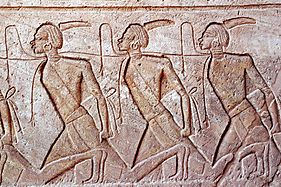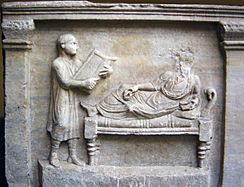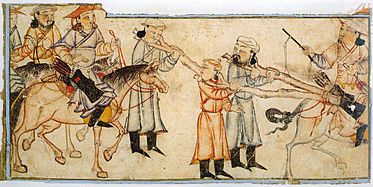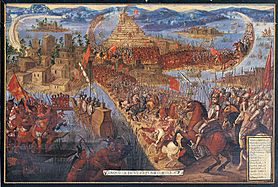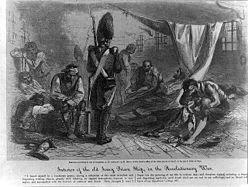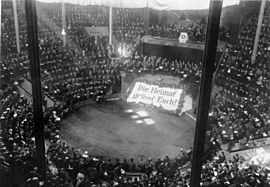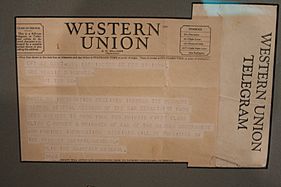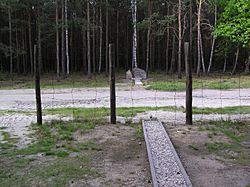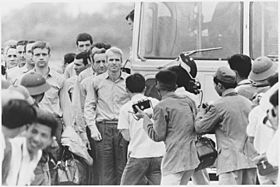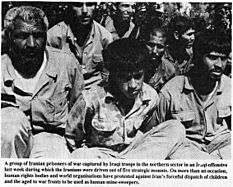Prisoner of war facts for kids

A prisoner of war (short form: POW) is a soldier or fighter captured by the enemy during a war. In the past, captured fighters often had no rights. They were sometimes killed or forced into slavery. Today, prisoners of war have special rights that are protected by international agreements called the Geneva Conventions and other laws of war. These rules make sure POWs are treated fairly.
Contents
What Are Their Rights?
The Third Geneva Convention is a very important agreement that gives prisoners of war many different rights. Here are some key examples:
- They must be treated with respect and decency.
- They must be allowed to tell their families and the International Committee of the Red Cross (ICRC) that they have been captured.
- They have the right to communicate with their families and receive packages from home.
- They can keep their clothing, eating utensils, and personal belongings.
- They must be given enough food, clothing, housing, and medical care.
- If their captors make them work, POWs must be paid for their labor.
- If they are accused of a crime, they must be given a fair trial.
If POWs become very sick or hurt, they have the right to be released. After a war ends, all prisoners of war must be set free quickly.
Prisoners of war also have rights about what they do NOT have to do:
- They do NOT have to give their captors any information, except for their name, age, rank, and military identification number.
- Their money or valuable items must NOT be stolen.
- They must NOT be forced to do forced labor, military work, or work that is dangerous, unhealthy, or degrading.
Who Gets These Rights?
Not everyone captured during a war is considered a "prisoner of war." The Third Geneva Convention has clear rules about who qualifies. For example, to be a "prisoner of war," soldiers MUST:
- Wear uniforms or clear marks on their clothes to show they are soldiers.
- Have a visible sign (like a flag) that shows they are soldiers from a distance.
- Carry their weapons openly, where they can be seen.
- Follow the laws of war.
If fighters do not meet these requirements, they are not "prisoners of war" under the Geneva Conventions. They are sometimes called "unlawful combatants." This means they do NOT have the special rights listed in the Geneva Conventions.
This topic became a big discussion in the early 2000s. For example, during the War in Afghanistan, the United States captured many fighters. The U.S. government said these people were "unlawful combatants" and did not have POW rights. This was because they often did not wear uniforms, did not have a clear military structure, and were linked to Al-Qaeda, a terrorist group.
Some of these captured people were taken to a prison at Guantánamo Bay. Because they were called "unlawful combatants," they did not receive the same rights that prisoners of war get under the Geneva Conventions.
History of Prisoners of War
Before the 20th Century
-
Engraving of Nubian POWs in Ancient Egypt (around 1300-1201 BC).
-
Relief of a slave (left) in Ancient Rome. The Roman Empire often made POWs into slaves.
-
Painting of Mongol riders with prisoners from the 14th century.
-
Spanish conquistadors invade the Aztec Empire in 1519. Many Aztec POWs were killed or enslaved.
-
American POWs from the Revolutionary War on a British prison ship.
20th Century and Beyond
-
Telegram sent to the family of an American POW captured by Nazi Germany during WWII.
-
In 1944, 76 Allied POWs escaped from a Nazi POW camp. Nazis recaptured 73 and killed 50.
-
North Vietnam releases some Vietnam War POWs, including John McCain, in 1973.
-
Iranian POWs, including child soldiers, captured during the Iran-Iraq War (1988).
-
Video of U.S. Marines and Navy SEALs rescuing American POW Jessica Lynch during the War in Iraq (2003).
Images for kids
-
Serbian Prisoners of war in Belgrade of the Austro-Hungarian forces during World War I, 1915.
-
Russian and Japanese prisoners being questioned by Chinese officials during the Boxer Rebellion.
-
German soldiers captured by British in Flanders.
-
German POW at Stalingrad.
-
Remagen open-field Rheinwiesenlager.
-
A group of Japanese soldiers captured during the Battle of Okinawa.
-
U.S. Army Nurses in Santo Tomas Internment Camp, 1943.
-
U.S. Navy nurses rescued from Los Baños Internment Camp, March 1945.
-
Canadian POWs at the Liberation of Hong Kong.
-
POW art depicting Cabanatuan prison camp, produced in 1946.
See also
 In Spanish: Prisionero de guerra para niños
In Spanish: Prisionero de guerra para niños



